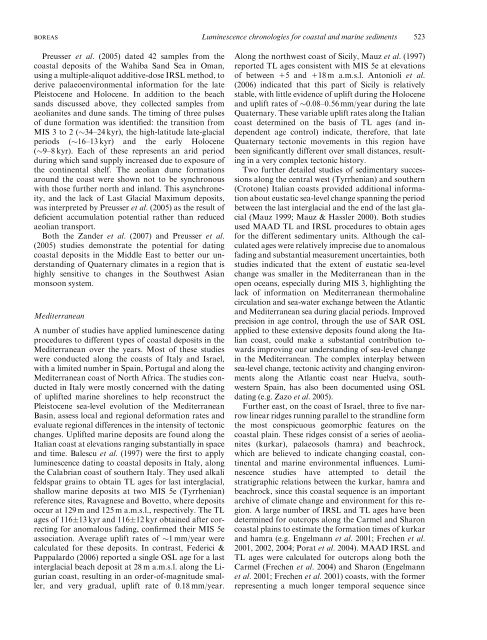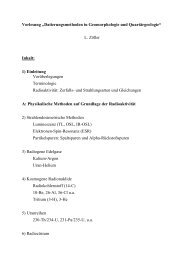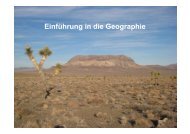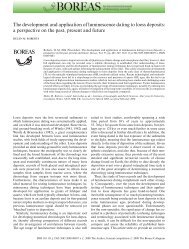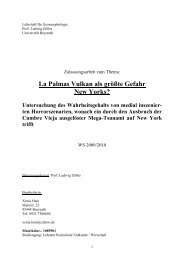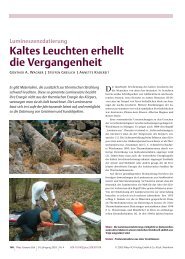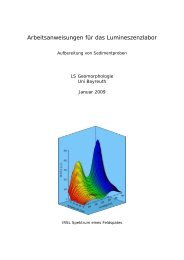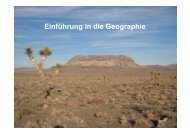Luminescence chronologies for coastal and marine sediments
Luminescence chronologies for coastal and marine sediments
Luminescence chronologies for coastal and marine sediments
Create successful ePaper yourself
Turn your PDF publications into a flip-book with our unique Google optimized e-Paper software.
BOREAS <strong>Luminescence</strong> <strong>chronologies</strong> <strong>for</strong> <strong>coastal</strong> <strong>and</strong> <strong>marine</strong> <strong>sediments</strong> 523<br />
Preusser et al. (2005) dated 42 samples from the<br />
<strong>coastal</strong> deposits of the Wahiba S<strong>and</strong> Sea in Oman,<br />
using a multiple-aliquot additive-dose IRSL method, to<br />
derive palaeoenvironmental in<strong>for</strong>mation <strong>for</strong> the late<br />
Pleistocene <strong>and</strong> Holocene. In addition to the beach<br />
s<strong>and</strong>s discussed above, they collected samples from<br />
aeolianites <strong>and</strong> dune s<strong>and</strong>s. The timing of three pulses<br />
of dune <strong>for</strong>mation was identified: the transition from<br />
MIS 3 to 2 (34–24 kyr), the high-latitude late-glacial<br />
periods (16–13 kyr) <strong>and</strong> the early Holocene<br />
(9–8 kyr). Each of these represents an arid period<br />
during which s<strong>and</strong> supply increased due to exposure of<br />
the continental shelf. The aeolian dune <strong>for</strong>mations<br />
around the coast were shown not to be synchronous<br />
with those further north <strong>and</strong> inl<strong>and</strong>. This asynchroneity,<br />
<strong>and</strong> the lack of Last Glacial Maximum deposits,<br />
was interpreted by Preusser et al. (2005) as the result of<br />
deficient accumulation potential rather than reduced<br />
aeolian transport.<br />
Both the Z<strong>and</strong>er et al. (2007) <strong>and</strong> Preusser et al.<br />
(2005) studies demonstrate the potential <strong>for</strong> dating<br />
<strong>coastal</strong> deposits in the Middle East to better our underst<strong>and</strong>ing<br />
of Quaternary climates in a region that is<br />
highly sensitive to changes in the Southwest Asian<br />
monsoon system.<br />
Mediterranean<br />
A number of studies have applied luminescence dating<br />
procedures to different types of <strong>coastal</strong> deposits in the<br />
Mediterranean over the years. Most of these studies<br />
were conducted along the coasts of Italy <strong>and</strong> Israel,<br />
with a limited number in Spain, Portugal <strong>and</strong> along the<br />
Mediterranean coast of North Africa. The studies conducted<br />
in Italy were mostly concerned with the dating<br />
of uplifted <strong>marine</strong> shorelines to help reconstruct the<br />
Pleistocene sea-level evolution of the Mediterranean<br />
Basin, assess local <strong>and</strong> regional de<strong>for</strong>mation rates <strong>and</strong><br />
evaluate regional differences in the intensity of tectonic<br />
changes. Uplifted <strong>marine</strong> deposits are found along the<br />
Italian coast at elevations ranging substantially in space<br />
<strong>and</strong> time. Balescu et al. (1997) were the first to apply<br />
luminescence dating to <strong>coastal</strong> deposits in Italy, along<br />
the Calabrian coast of southern Italy. They used alkali<br />
feldspar grains to obtain TL ages <strong>for</strong> last interglacial,<br />
shallow <strong>marine</strong> deposits at two MIS 5e (Tyrrhenian)<br />
reference sites, Ravagnese <strong>and</strong> Bovetto, where deposits<br />
occur at 129 m <strong>and</strong> 125 m a.m.s.l., respectively. The TL<br />
ages of 11613 kyr <strong>and</strong> 11612 kyr obtained after correcting<br />
<strong>for</strong> anomalous fading, confirmed their MIS 5e<br />
association. Average uplift rates of 1 mm/year were<br />
calculated <strong>for</strong> these deposits. In contrast, Federici &<br />
Pappalardo (2006) reported a single OSL age <strong>for</strong> a last<br />
interglacial beach deposit at 28 m a.m.s.l. along the Ligurian<br />
coast, resulting in an order-of-magnitude smaller,<br />
<strong>and</strong> very gradual, uplift rate of 0.18 mm/year.<br />
Along the northwest coast of Sicily, Mauz et al. (1997)<br />
reported TL ages consistent with MIS 5e at elevations<br />
of between 15 <strong>and</strong> 118 m a.m.s.l. Antonioli et al.<br />
(2006) indicated that this part of Sicily is relatively<br />
stable, with little evidence of uplift during the Holocene<br />
<strong>and</strong> uplift rates of 0.08–0.56 mm/year during the late<br />
Quaternary. These variable uplift rates along the Italian<br />
coast determined on the basis of TL ages (<strong>and</strong> independent<br />
age control) indicate, there<strong>for</strong>e, that late<br />
Quaternary tectonic movements in this region have<br />
been significantly different over small distances, resulting<br />
in a very complex tectonic history.<br />
Two further detailed studies of sedimentary successions<br />
along the central west (Tyrrhenian) <strong>and</strong> southern<br />
(Crotone) Italian coasts provided additional in<strong>for</strong>mation<br />
about eustatic sea-level change spanning the period<br />
between the last interglacial <strong>and</strong> the end of the last glacial<br />
(Mauz 1999; Mauz & Hassler 2000). Both studies<br />
used MAAD TL <strong>and</strong> IRSL procedures to obtain ages<br />
<strong>for</strong> the different sedimentary units. Although the calculated<br />
ages were relatively imprecise due to anomalous<br />
fading <strong>and</strong> substantial measurement uncertainties, both<br />
studies indicated that the extent of eustatic sea-level<br />
change was smaller in the Mediterranean than in the<br />
open oceans, especially during MIS 3, highlighting the<br />
lack of in<strong>for</strong>mation on Mediterranean thermohaline<br />
circulation <strong>and</strong> sea-water exchange between the Atlantic<br />
<strong>and</strong> Mediterranean sea during glacial periods. Improved<br />
precision in age control, through the use of SAR OSL<br />
applied to these extensive deposits found along the Italian<br />
coast, could make a substantial contribution towards<br />
improving our underst<strong>and</strong>ing of sea-level change<br />
in the Mediterranean. The complex interplay between<br />
sea-level change, tectonic activity <strong>and</strong> changing environments<br />
along the Atlantic coast near Huelva, southwestern<br />
Spain, has also been documented using OSL<br />
dating (e.g. Zazo et al. 2005).<br />
Further east, on the coast of Israel, three to five narrow<br />
linear ridges running parallel to the str<strong>and</strong>line <strong>for</strong>m<br />
the most conspicuous geomorphic features on the<br />
<strong>coastal</strong> plain. These ridges consist of a series of aeolianites<br />
(kurkar), palaeosols (hamra) <strong>and</strong> beachrock,<br />
which are believed to indicate changing <strong>coastal</strong>, continental<br />
<strong>and</strong> <strong>marine</strong> environmental influences. <strong>Luminescence</strong><br />
studies have attempted to detail the<br />
stratigraphic relations between the kurkar, hamra <strong>and</strong><br />
beachrock, since this <strong>coastal</strong> sequence is an important<br />
archive of climate change <strong>and</strong> environment <strong>for</strong> this region.<br />
A large number of IRSL <strong>and</strong> TL ages have been<br />
determined <strong>for</strong> outcrops along the Carmel <strong>and</strong> Sharon<br />
<strong>coastal</strong> plains to estimate the <strong>for</strong>mation times of kurkar<br />
<strong>and</strong> hamra (e.g. Engelmann et al. 2001; Frechen et al.<br />
2001, 2002, 2004; Porat et al. 2004). MAAD IRSL <strong>and</strong><br />
TL ages were calculated <strong>for</strong> outcrops along both the<br />
Carmel (Frechen et al. 2004) <strong>and</strong> Sharon (Engelmann<br />
et al. 2001; Frechen et al. 2001) coasts, with the <strong>for</strong>mer<br />
representing a much longer temporal sequence since


